How to Keep Your Dog Safe in Cars: Tips for Pet Owners
Posted: 11/06/2023 | BY: Erin Cain | Categories: Uncategorized
As a dog owner, it’s essential to keep your pup safe while driving. Many people travel with their dogs, whether for a day at the park or on vacation with family. But as any pet owner knows, you need to be mindful of your dog’s safety while driving. According to the AAA, 84% of pup parents drive with their dog, but only 16% use a car restraint. You can do many things to ensure your dog is secure and doesn’t pose a danger to yourself or other drivers. This blog post will discuss some tips for keeping your dog safe in cars. Follow these guidelines, and you can travel with peace of mind, knowing that your dog is safe and sound.
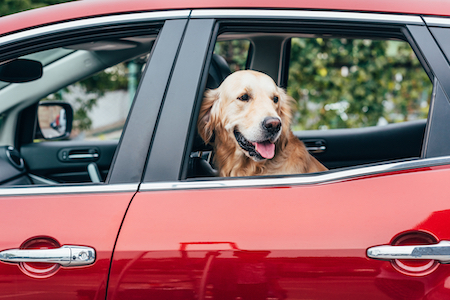
Secure your dog safely in the car.
Letting an unrestrained dog have free reign to move about your vehicle is a recipe for disaster. Research shows that during a car crash at 35mph, a 60-pound dog loose in the car turns into a projectile of 2,700 pounds. Both you and your dog are at high risk for severe injury or death at that speed.
A dog sitting in a driver’s lap asks for both a driving distraction and a potential blind spot, preventing the driver from seeing all parts of the road. Additionally, distracted driving, including having an unsecured pet in your car, is illegal in some states. Check your state’s distracted driving laws to see what is illegal in your hometown.
If you have a dog that spends time in the front seat, be aware of the risk of injury. Airbags are crash tested for adult people, not canines. Dogs can get injured or killed by airbags if they deploy. An unsecured dog in a vehicle risks ejection from the car during a crash. The result may be severe injury, death, or loss if the dog runs away in a panic. That’s why dog owners need to have pet safety products in their vehicles to protect their furry friends.
Use travel crates or kennels.
Your dog safe in the car is by using a hard-sided kennel or travel crate. It should have ample space for them to turn around and lie down and plenty of ventilation so they stay comfortable while you drive. For added safety purposes, try adding some soft bedding to the base of the crate.
Crates and kennels offer an excellent way to protect your dog from flying objects in the car (such as when you’ve had an accident or quick stop). They also keep dogs safe and properly restrained so they can’t injure themselves by ricocheting off surfaces in the car. A securely latched kennel door will keep your dog from escaping in an accident. And, of course, a crate can stop a dog from running around a moving vehicle and distracting the driver.
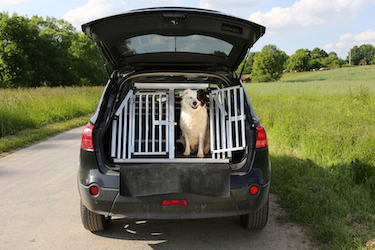
Use a dog car harness or seatbelt.
One of the most important things to keep your dog safe while driving is to ensure they’re properly secured in their safety harness or seatbelt. There’s a variety of styles and brands of harnesses that will provide proper restraints for all breeds and sizes. A safety harness includes an attachment point at the back or through another connecting point that you can place through the car’s seatbelt. Click this part of the dog harness into the seatbelt component, and your dog is safely secured in the seat.
A canine seat belt is another way to keep your dog safe and sound in the car. Seat belts are designed for any vehicle, from small cars to minivans to trucks. When shopping for a car seat, you must find one with wide straps or padded chest pieces so the dog’s harness fits comfortably. The tether, which connects to your dog’s safety belt, should also be short enough not to allow them to move forward too much in case there’s an accident or sudden stop.
Use a booster seat.
A small dog or puppy may also benefit from a car seat and a seatbelt or harness. Look for a dog car seat that connects to your vehicle’s existing seat belt while also providing an additional harness to fit small dogs. Booster seats are essentially a harness and seat belt combination but designed specifically for little dogs. It’s easier for a small dog to be flung about a car or fall out of a vehicle. A booster seat ensures that the dog stays securely attached and properly restrained.
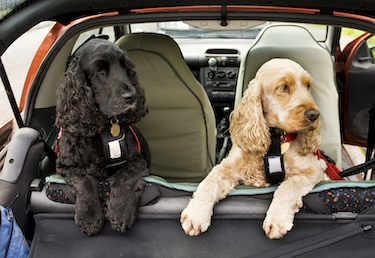
Install a back seat hammock or barrier.
Canine barriers are designed to protect both you and your four-legged friend from injury in the event of a collision. This safety product is used either as a barrier between the front and back seats or between the back seats and cargo area.
Some barriers are part of an entire hammock, which gives your pup a more comfortable seat and protects the car seats from dirty paws and wear and tear. The barrier prevents your dog from climbing into the front seat and distracting the driver, and stopping your dog’s body from being launched forward in an accident.
Although a barrier is better than no protection for your dog, it won’t stop your dog from being ejected out a door or window. Even for the most well-behaved dogs, the right solution for ultimate canine car safety is a harness or seat belt in addition to a barrier.
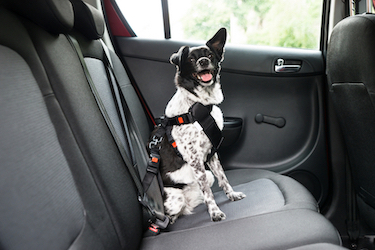
Keep paws and snouts inside.
Many dogs love to put their head out the car window. Some pups even put their paws up on the sill! Canines love the exposure to new scents and the feel of the air and wind on their faces. Although there are few things more adorable than seeing a happy dog with her head and tongue hanging out of a car window, it’s a dangerous situation for your pup.
Leaning out of the car.
One danger with dogs in cars is that they can lean too far out the window and fall out of the vehicle. This situation happens more often than pup parents may think, even with partially lowered windows. Suppose your dog is reactive to other pets or wildlife, such as squirrels. The chances of your pup jumping out to chase the prey increase. Those odds go even higher if the car is stopped.
Sudden stops and debris.
Should you have to stop suddenly or brake hard, your dog can sail out of the car and be injured or killed. Additionally, when car windows are down, the vehicle’s inside is exposed to any debris that is either blown into it or kicked up by the car tires. Small stones, pieces of glass, or bugs can quickly become small projectiles that can strike your pup’s face or embed themselves into the eyes.
Accidents and loss of vehicular control
You can lose control of your car and swipe the side of the vehicle that your dog is hanging her head out of, seriously injuring her. Or, your car could be the one hit on the side your dog is on. The best way to be safe is not to allow your dog to have any part of her body outside of the car or keep the glass cracked slightly, so your pup can still get all those good smells while remaining behind the glass.
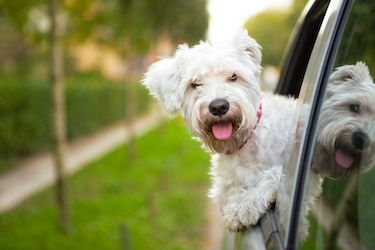
Don’t let your dog overheat!
Dogs are susceptible to heatstroke. While most pet parents know that leaving a dog in a hot car is wrong, some may still think that it’s safe for a dog for a few minutes if the glass is open. The answer is a simple no.
Dogs are highly susceptible to heatstroke, also called canine hyperthermia. Once a dog’s body cannot regulate her temperature through panting and the paws, she begins to overheat. Body temperatures rise 2 to 5 degrees over the canine baseline temperature (101 – 102 degrees Fahrenheit) and cannot come down. A dog with heatstroke suffers tremendously, and if the body temperature rises above 106 degrees, permanent organ and brain damage occurs. While some dogs recover from heatstroke, many others don’t survive.
The inside of a car can reach 110 degrees Fahrenheit in just 20 minutes in 70-degree weather. On even hotter days, that temperature can get 140 degrees in a car in less than 60 minutes. The American Veterinary Medical Association notes that cracking the window of a vehicle has no impact on the climbing temperatures in the car. The best way to keep your dog safe is never to leave her in a parked car, not even for a few minutes.
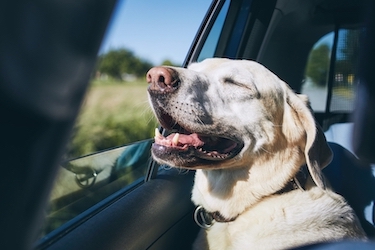
Deter motion sickness in your pup.
Carsickness will make anyone miserable, your dog included. Often, nausea is caused by stress and accompanied by vomiting and drooling. Here are some methods to try that may help your dog overcome car illness:
- Don’t feed your dog before the car ride. Avoid giving your pup food six to eight hours before the car ride. Dogs who don’t eat food before traveling by car are less likely to get sick.
- Bring distractions. Whether it’s your dog’s favorite toy, a frozen peanut butter Kong, or a family member, keeping your dog focused on anything but the car’s movement can help deter carsickness.
- Stop frequently. Make a pit stop every hour or two to let your dog outside. They can go to the bathroom, stretch their legs, breathe fresh air, and you can even give them some water or ice during these stops.
- Open the windows, and turn off the AC. Don’t open your windows far enough for your dog to fall out or jump! Open the windows sufficiently so that fresh air circulates through the car. Constant exposure to vehicle air conditioning upsets some dogs’ tummies.
- Talk with your veterinarian. A veterinarian may prescribe anti-car sickness medication to prevent your pup from experiencing extreme nausea in severe motion sickness cases.
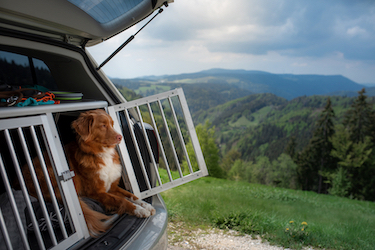
Protect your dog with pet insurance.
Your dog can experience an emergency anywhere, but when your pup is in a car, especially frequently, the odds of them being injured in an accident rise. Should that event happen and your dog needs emergency surgery or care, the costs for that treatment are enormous. With a pet insurance plan, you won’t have to worry about how you will pay for your dog’s unexpected veterinary bills. Depending on your choice of policy, most plans offer up to 90% reimbursement of your dog’s care costs.
At Pet Insurance Review, we never want to see a pet parent put in a situation where they have to choose between their pet’s medical treatment and financial means. We’ll help you find the pet health insurance plan that best fits your budget and your pet’s needs. Get a free insurance quote today, so you’ll be prepared for your pet’s tomorrow.
References:
- AAA Go. (2019). Pet Passenger Safety. Retrieved from https://go.carolinas.aaa.com/expert-advice/traffic-safety/pet-passenger-safety/
- Siler, W. (2018). We Need to Talk About Keeping Dogs Safe in Cars. Retrieved from https://www.outsideonline.com/outdoor-gear/tools/we-need-talk-about-keeping-dogs-safe-cars/
- Orvis Staff. (2021). Does Your State Require Dogs Be Harnessed In The Car? Retrieved from https://news.orvis.com/dogs/does-your-state-require-dogs-be-harnessed-in-the-car
- Russell, R. (2010). Air bags and lap dogs a deadly combination. Retrieved from https://www.theglobeandmail.com/globe-drive/culture/commuting/air-bags-and-lap-dogs-a-deadly-combination/article1241056/
- Mayersohn, N. (2019). Dogs in Cars, Getting There Safely. Retrieved from https://www.nytimes.com/2019/12/17/smarter-living/dogs-cars-safe-travel.html
- Bina, J. (2020). Pet Seat Belts — Where It’s the Law and Why It Matters. Retrieved from https://blog.pettravel.com/index.php/pet-seat-belts/
- Glen Oak Animal Hospital. (2020). Dogs and Heat Stroke: 11 risk factors & warning signs and how to prevent it. Retrieved from https://glenoakanimalhospital.com/dogs-prevent-heat-stroke/
- AVMA. (2022). Pets in vehicles. Retrieved from https://www.avma.org/resources-tools/pet-owners/petcare/pets-vehicles
- Nicholas, J. (2021). Preventing and Treating Car Sickness in Dogs. Retrieved from https://www.preventivevet.com/dogs/preventing-and-treating-car-sickness-in-dogs
Disclaimer
The information contained on this blog is intended for informational and educational purposes only and should not be construed as medical advice. It is not a substitute for professional veterinary care. Always consult with your veterinarian before making any changes to your pet's health care or treatment plan.
The authors of this blog are not veterinarians and do not claim to be experts in pet health. The information provided here is based on our own experiences and research, as well as information from reputable sources. However, we cannot guarantee the accuracy or completeness of this information.
We encourage you to do your own research and consult with your veterinarian before making any decisions about your pet's health.
Previous post
Creating a puppy paradise, or what I’ve learned so far!Next post
Tips for Hiking with Small DogsCompare top pet insurance providers plans.
Enter your dog’s age in years and months to calculate their age equivalent to human years.
Calculate your dog’s ageEnter your cat’s age in years and months to calculate their age equivalent to human years.
Calculate your cat’s age